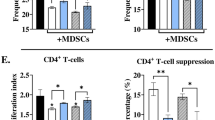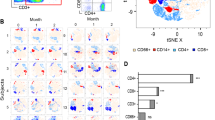Abstract
Pathogenic yeast and fungi represent a major group of human pathogens. The consequences of infections are diverse and range from local, clinically uncomplicated mycosis of the skin to systemic, life-threatening sepsis. Despite extensive MHC class I-restricted frequencies of yeast-specific CD8 T lymphocytes in healthy individuals and the essential role of the cell-mediated immunity in controlling infections, the characteristics and defense mechanisms of antifungal effector cells are still unclear. Here, we describe the direct analysis of yeast-specific CD8 T lymphocytes in whole blood from healthy individuals. They show a unique, nonclassical phenotype expressing granulysin and granzyme K in lytic granules instead of the major effector molecules perforin and granzyme B. After stimulation in whole blood, yeast-specific CD8 T cells degranulated and, upon cultivation in the presence of IL-2, their granula were refilled with granulysin rather than with perforin and granzyme B. Moreover, yeast-specific stimulation through dendritic cells but not by yeast cells alone led to degranulation of the effector cells. As granulysin is the only effector molecule in lytic granules known to have antifungal properties, our data suggest yeast-specific CD8 T cells to be a nonclassical effector population whose antimicrobial effector machinery seems to be tailor-made for the efficient elimination of fungi as pathogens.




Similar content being viewed by others
References
Pfaller MA, Moet GJ, Messer SA, Jones RN, Castanheira M (2010) Candida bloodstream infections: comparison of species distributions and antifungal resistance patterns in community-onset and nosocomial isolates in the SENTRY antimicrobial surveillance program, 2008–2009. Antimicrob Agents Chemother 55:561–566
Shoham S, Levitz SM (2005) The immune response to fungal infections. Br J Haematol 129:569–582
Richards MJ, Edwards JR, Culver DH, Gaynes RP (1999) Nosocomial infections in medical intensive care units in the United States. National nosocomial infections surveillance system. Crit Care Med 27:887–892
Wey SB, Mori M, Pfaller MA, Woolson RF, Wenzel RP (1989) Risk factors for hospital-acquired candidemia. A matched case-control study. Arch Intern Med 149:2349–2353
Romani L (2004) Immunity to fungal infections. Nat Rev Immunol 4:1–23
Sohn K, Urban C, Brunner H, Rupp S (2003) EFG1 is a major regulator of cell wall dynamics in Candida albicans as revealed by DNA microarrays. Mol Microbiol 47:89–102
d’Ostiani CF, Del Sero G, Bacci A, Montagnoli C, Spreca A, Mencacci A, Ricciardi-Castagnoli P, Romani L (2000) Dendritic cells discriminate between yeasts and hyphae of the fungus Candida albicans. Implications for initiation of T helper cell immunity in vitro and in vivo. J Exp Med 191:1661–1674
Lorenz MC, Bender JA, Fink GR (2004) Transcriptional response of Candida albicans upon internalization by macrophages. Eukaryot Cell 3:1076–1087
Cutler JE, Deepe GS Jr, Klein BS (2007) Advances in combating fungal diseases: vaccines on the threshold. Nat Rev Microbiol 5:13–28
Mukherjee J, Nussbaum G, Scharff MD, Casadevall A (1995) Protective and nonprotective monoclonal antibodies to Cryptococcus neoformans originating from one B cell. J Exp Med 181:405–409
Romani L, Puccetti P, Bistoni F (1996) Biological role of Th cell subsets in candidiasis. Chem Immunol 63:115–137
Lopez-Ribot JL, Casanova M, Murgui A, Martinez JP (2004) Antibody response to Candida albicans cell wall antigens. FEMS Immunol Med Microbiol 41:187–196
Matthews R, Burnie J (2001) Antifungal antibodies: a new approach to the treatment of systemic candidiasis. Curr Opin Investig Drugs 2:472–476
Levitz SM (1992) Overview of host defenses in fungal infections. Clin Infect Dis 14(Suppl 1):S37–S42
Romani L, Howard DH (1995) Mechanisms of resistance to fungal infections. Curr Opin Immunol 7:517–523
Huffnagle GB, Deepe GS (2003) Innate and adaptive determinants of host susceptibility to medically important fungi. Curr Opin Microbiol 6:344–350
Decken K, Kohler G, Palmer-Lehmann K, Wunderlin A, Mattner F, Magram J, Gately MK, Alber G (1998) Interleukin-12 is essential for a protective Th1 response in mice infected with Cryptococcus neoformans. Infect Immun 66:4994–5000
Acosta-Rodriguez EV, Rivino L, Geginat J, Jarrossay D, Gattorno M, Lanzavecchia A, Sallusto F, Napolitani G (2007) Surface phenotype and antigenic specificity of human interleukin 17-producing T helper memory cells. Nat Immunol 8:639–646
Heintel T, Breinig F, Schmitt MJ, Meyerhans A (2003) Extensive MHC class I-restricted CD8 T lymphocyte responses against various yeast genera in humans. FEMS Immunol Med Microbiol 39:279–286
Barry M, Bleackley RC (2002) Cytotoxic T lymphocytes: all roads lead to death. Nat Rev Immunol 2:401–409
Lieberman J (2003) The ABCs of granule-mediated cytotoxicity: new weapons in the arsenal. Nat Rev Immunol 3:361–370
Griffiths GM (1995) The cell biology of CTL killing. Curr Opin Immunol 7:343–348
Harari A, Enders FB, Cellerai C, Bart PA, Pantaleo G (2009) Distinct profiles of cytotoxic granules in memory CD8 T cells correlate with function, differentiation stage, and antigen exposure. J Virol 83:2862–2871
Trapani JA, Smyth MJ (2002) Functional significance of the perforin/granzyme cell death pathway. Nat Rev Immunol 2:735–747
Zhao T, Zhang H, Guo Y, Fan Z (2007) Granzyme K directly processes bid to release cytochrome c and endonuclease G leading to mitochondria-dependent cell death. J Biol Chem 282:12104–12111
Ernst WA, Thoma-Uszynski S, Teitelbaum R, Ko C, Hanson DA, Clayberger C, Krensky AM, Leippe M, Bloom BR, Ganz T, Modlin RL (2000) Granulysin, a T cell product, kills bacteria by altering membrane permeability. J Immunol 165:7102–7108
Ma LL, Spurrell JC, Wang JF, Neely GG, Epelman S, Krensky AM, Mody CH (2002) CD8 T cell-mediated killing of Cryptococcus neoformans requires granulysin and is dependent on CD4 T cells and IL-15. J Immunol 169:5787–5795
Stenger S, Hanson DA, Teitelbaum R, Dewan P, Niazi KR, Froelich CJ, Ganz T, Thoma-Uszynski S, Melian A, Bogdan C, Porcelli SA, Bloom BR, Krensky AM, Modlin RL (1998) An antimicrobial activity of cytolytic T cells mediated by granulysin. Science 282:121–125
Huang LP, Lyu SC, Clayberger C, Krensky AM (2007) Granulysin-mediated tumour rejection in transgenic mice. J Immunol 178:77–84
Hata A, Zerboni L, Sommer M, Kaspar AA, Clayberger C, Krensky AM, Arvin AM (2001) Granulysin blocks replication of varicella-zoster virus and triggers apoptosis of infected cells. Viral Immunol 14:125–133
Pardo J, Perez-Galan P, Gamen S, Marzo I, Monleon I, Kaspar AA, Susin SA, Kroemer G, Krensky AM, Naval J, Anel A (2001) A role of the mitochondrial apoptosis-inducing factor in granulysin-induced apoptosis. J Immunol 167:1222–1229
Thoma-Uszynski S, Stenger S, Modlin RL (2000) CTL-mediated killing of intracellular Mycobacterium tuberculosis is independent of target cell nuclear apoptosis. J Immunol 165:5773–5779
Breinig T, Sester M, Sester U, Meyerhans A (2006) Antigen-specific T cell responses: determination of their frequencies, homing properties, and effector functions in human whole blood. Methods 38:77–83
Betts MR, Brenchley JM, Price DA, De Rosa SC, Douek DC, Roederer M, Koup RA (2003) Sensitive and viable identification of antigen-specific CD8+ T cells by a flow cytometric assay for degranulation. J Immunol Methods 281:65–78
Schutz A, Scheller N, Breinig T, Meyerhans A (2006) The Autographa californica nuclear polyhedrosis virus AcNPV induces functional maturation of human monocyte-derived dendritic cells. Vaccine 24:7190–7196
Heintel T, Sester M, Rodriguez MM, Krieg C, Sester U, Wagner R, Pees HW, Gartner B, Maier R, Meyerhans A (2002) The fraction of perforin-expressing HIV-specific CD8 T cells is a marker for disease progression in HIV infection. Aids 16:1497–1501
Wang Z, Choice E, Kaspar A, Hanson D, Okada S, Lyu SC, Krensky AM, Clayberger C (2000) Bactericidal and tumoricidal activities of synthetic peptides derived from granulysin. J Immunol 165:1486–1490
Pena SV, Hanson DA, Carr BA, Goralski TJ, Krensky AM (1997) Processing, subcellular localization, and function of 519 (granulysin), a human late T cell activation molecule with homology to small, lytic, granule proteins. J Immunol 158:2680–2688
Zheng CF, Ma LL, Jones GJ, Gill MJ, Krensky AM, Kubes P, Mody CH (2007) Cytotoxic CD4+ T cells use granulysin to kill Cryptococcus neoformans, and activation of this pathway is defective in HIV patients. Blood 109:2049–2057
Beno DW, Stover AG, Mathews HL (1995) Growth inhibition of Candida albicans hyphae by CD8+ lymphocytes. J Immunol 154:5273–5281
Levitz SM, North EA (1996) gamma Interferon gene expression and release in human lymphocytes directly activated by Cryptococcus neoformans and Candida albicans. Infect Immun 64:1595–1599
Wuthrich M, Filutowicz HI, Warner T, Deepe GS Jr, Klein BS (2003) Vaccine immunity to pathogenic fungi overcomes the requirement for CD4 help in exogenous antigen presentation to CD8+ T cells: implications for vaccine development in immune-deficient hosts. J Exp Med 197:1405–1416
Lettau M, Schmidt H, Kabelitz D, Janssen O (2007) Secretory lysosomes and their cargo in T and NK cells. Immunol Lett 108:10–19
Zhou P, Freidag BL, Caldwell CC, Seder RA (2001) Perforin is required for primary immunity to Histoplasma capsulatum. J Immunol 166:1968–1974
Fehniger TA, Cai SF, Cao X, Bredemeyer AJ, Presti RM, French AR, Ley TJ (2007) Acquisition of murine NK cell cytotoxicity requires the translation of a pre-existing pool of granzyme B and perforin mRNAs. Immunity 26:798–811
Glimcher LH, Townsend MJ, Sullivan BM, Lord GM (2004) Recent developments in the transcriptional regulation of cytolytic effector cells. Nat Rev Immunol 4:900–911
Intlekofer AM, Banerjee A, Takemoto N, Gordon SM, Dejong CS, Shin H, Hunter CA, Wherry EJ, Lindsten T, Reiner SL (2008) Anomalous type 17 response to viral infection by CD8+ T cells lacking T-bet and eomesodermin. Science 321:408–411
Kaufmann SH (1988) CD8+ T lymphocytes in intracellular microbial infections. Immunol Today 9:168–174
Ludewig B, Bonilla WV, Dumrese T, Odermatt B, Zinkernagel RM, Hengartner H (2001) Perforin-independent regulation of dendritic cell homeostasis by CD8(+) T cells in vivo: implications for adaptive immunotherapy. Eur J Immunol 31:1772–1779
Acknowledgments
The work was supported by the European Society of Clinical Microbiology and Infectious Diseases (ESCMID), the Forschungsförderung HOMFOR of the Saarland University to TB and the Spanish Ministry of Science and Innovation (SAF2010-21336) to AM. We thank Dr. Reinhard Maier for helpful discussions.
Author information
Authors and Affiliations
Corresponding author
Rights and permissions
About this article
Cite this article
Breinig, T., Scheller, N., Glombitza, B. et al. Human yeast-specific CD8 T lymphocytes show a nonclassical effector molecule profile. Med Microbiol Immunol 201, 127–136 (2012). https://doi.org/10.1007/s00430-011-0213-2
Received:
Published:
Issue Date:
DOI: https://doi.org/10.1007/s00430-011-0213-2




